










The mural is an idea given to me, by God, as an inspirational and educational tool about Black America’s experience, from Jamestown to the White House.
The 5000 sq. ft. mural, hand drawn and completed by a local artist, Chris Rogers, provides an opportunity to reinvigorate the tradition of storytelling, as viewers draw on and share their personal experiences triggered by images that remind them of a space and time in their lives.
Storytelling in African American culture is a deeply rooted tradition that served as a primary way to preserve history, pass down cultural values, and provide a sense of community, often utilizing folktales and oral narratives to convey experiences of resilience, struggle, tragedy and triumph, particularly during slavery when literacy was restricted. Before being allowed to learn how to read and write, slaves kept the history, the values, and the customs of our forefathers alive through the oral tradition of storytelling.
The mural is an abbreviated depiction of our cultural, ancestral history of character, integrity, leadership, and determination. The mural embodies people representing significant events and milestones dating from entrapment and enslavement to the survival, freedom, and still fractioned inclusion of our forefathers.
It expands generations and includes depictions of a millennial generation of African American history-makers walking under the cover of those that toiled before them, unveiling a generation now forging a new path, through their own ambitious achievements, for others to follow. It is but a mere part of the story of the African American experience; to remind us of how far we have come and how far we still need to go.
PASTOR DANTE D. WRIGHT I, Ph.D.
*A legend and a brief bio is included for each African-American hero.
Sweet Home Baptist Church of Round Rock (affectionately known as – The Pinnacle of Praise), founded, January 8, 1905, is the second oldest AfricanAmerican, Baptist church in Round Rock, Texas.
Arriving from the rural farming town of Sprinkle, Texas, just nine miles northeast of Austin, Reverend S. W. Wormley traveled to Round Rock to become the first pastor of Sweet Home Baptist Church, the second black Baptist church in Round Rock, Texas.
Reverend S.W. Wormley, a small committee of the area’s religious leaders, and twenty-two enthusiastic Christians with a vision and a love for God, faithfully planted their new church home.
The land was donated by Bro. Mitchell Mays and the church home was named Sweet Home Baptist Church. The members (remove “were”) bound in unity to create an assembly to support their spiritual, educational, social, political and cultural needs.
Sweet Home was originally located at 706 Morrell, Round Rock, Texas. On May 12, 1985, the membership celebrated a 1.2-mile candlelight march from its original site to its new site located at 800 Deepwood Drive, Round Rock, Texas. Participants in the march ranged in age from infancy to 79 years old.
Since her inception on January 8, 1905, Sweet Home has established a rich heritage of assembling God's people, and the Lord has given her a legacy of dynamic leaders to shepherd His flock.
There are no shortcuts to excellence and there are no shortcuts to growth in Christ. More than 100 years and seasons of exponential growth later, Sweet Home Baptist Church of Round Rock is drawing from its deep well of her past, serving and standing strong in the present and building for her future.

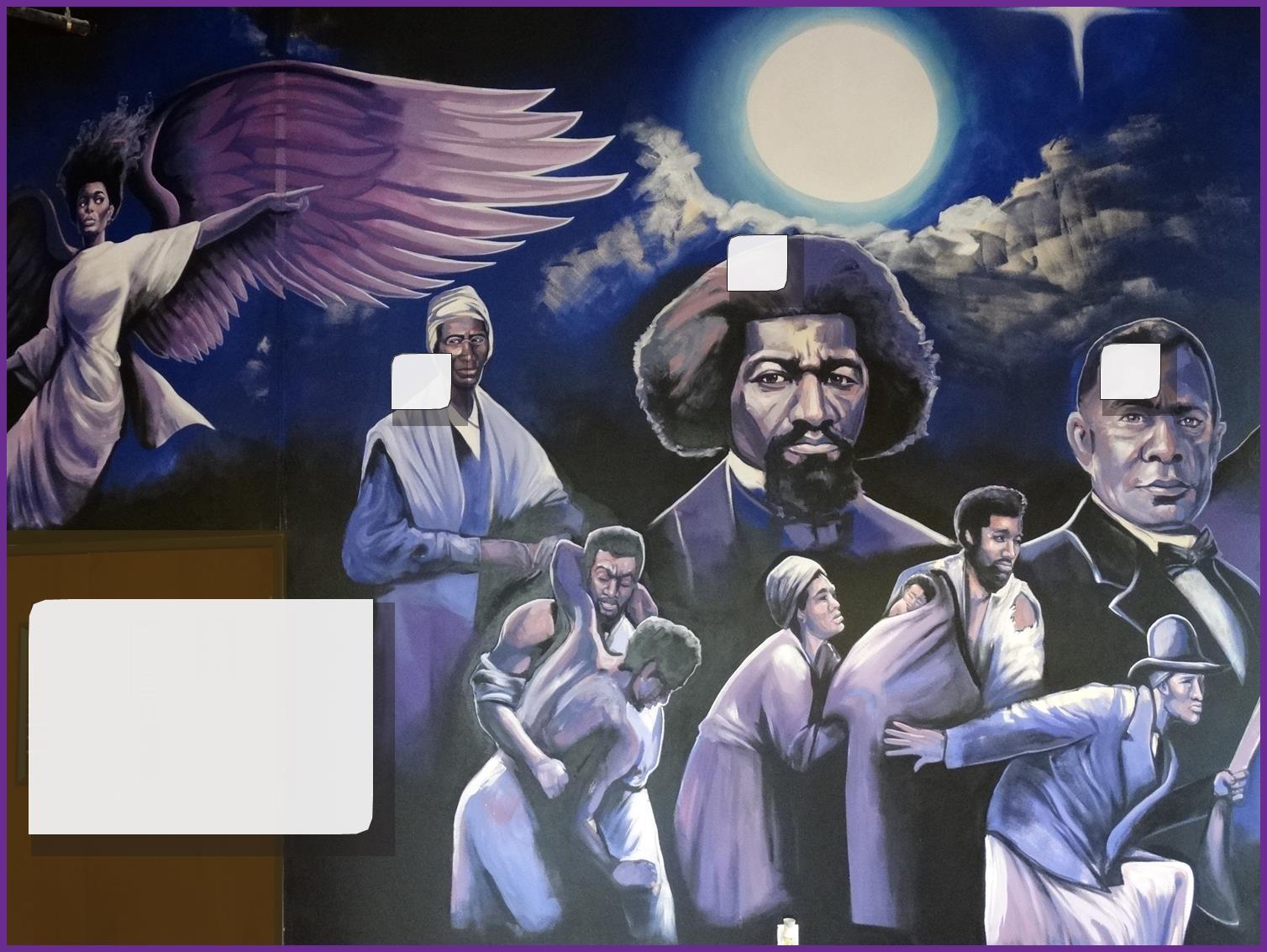
4. W.E.B. DUBOIS PAGE 13
5. PAGE 14

6. THURGOOD MARSHALL PAGE 14
7. PAGE 15
8. MALCOM X PAGE 15
9. PAGE 16
10. ROSA M.
PAGE 16
11. PAGE 17

12. JOHN CARLOS & TOMMIE
1968 OLYMPICS PAGE 17 13. PAGE 18 14. NINA SIMONE PAGE 18 15. PAGE 19 16. MUHAMMAD ALI PAGE 19 17. PAGE 20 18. ELA FITZGERALD PAGE 20


24. ARETHA FRANKLIN PAGE 23
25. PAGE 24

25. RAY CHARLES PAGE 24
26. PAGE 25
27. TINA TURNER PAGE 25
28. PAGE 26
29. PAGE 26
30. MILES DAVIS PAGE 27
31. PAGE 27
33. JIMI HENDRIX PAGE 28

PAGE 28
PAGE 32 36. LUTHER VANDROSS PAGE 29
PAGE 33
37. PAGE 30 38. PAGE 30 42. BEYONCE KNOWLES PAGE 32

19. PAGE 33
20. BRIAN D. WATERS PAGE 34
21. BARACK OBAMA PAGE 34
22. MICHELLE OBAMA PAGE 35
Sojourner Truth was born Isabella Baumfree in Ulster County, New York. The actual date of birth for many slaves was not recorded, but historians estimate that she was likely born around 1797. Truth was born into slavery but escaped with her infant daughter to freedom in 1826.
Shortly after her escape, Truth learned that her son Peter, then five years old, had been illegally sold to a man in Alabama. She took the issue to court and eventually secured Peter’s return from the South. She was the first black woman to successfully challenge a white man in a United States court.

Women's Rights Activist, Civil Rights Activist (c. 1797 - 1883)
Sojourner Truth, a native of New York, whose first language was Dutch, did not learn to speak English until she was 11 years old; but that did not hinder her ambition. She became an African American abolitionist and women’s rights activist and was best-known for her speech on racial inequalities. She devoted her life to the abolitionist cause to free slaves and helped to recruit black troops for the Union Army, during the Civil War. Although Truth began her career as an abolitionist, she sponsored various reform causes, including property rights and universal voting rights.
During the Civil War, Truth traveled the roads of Michigan collecting food and clothing for black regiments. She traveled to Washington, D.C., where on at least one occasion, Truth met and spoke with President Abraham Lincoln about her beliefs and her experience. Truth staged the first sit-in and attempted to force the desegregation of streetcars in Washington by riding in cars designated for whites only.
Truth is remembered as one of the foremost leaders of the abolition movement and an early advocate of women’s rights. Abolition was one of the few causes that Truth was able to see realized in her lifetime.
Sojourner Truth died at her home in Battle Creek, Michigan, on November 26, 1883.
Truth was a powerful and impassioned speaker whose legacy of feminism and racial equality still resonates today. She is perhaps best known for her stirring “Ain’t I A Woman?” speech, delivered at a women’s convention in Ohio in 1851.
Frederick Douglass was born into slavery around 1818 in Talbot County, Maryland; and, demonstrated a passion for learning at an early age; and, although it was forbidden for slaves to learn how to read and write, the wife of Frederick Douglass’s owner taught him the alphabet when he was 12 years old.
Frederick Douglass became one of the most famous intellectuals of his time. He advised presidents and lectured to thousands, of people around the world, about many causes, including women’s rights and the evils of slavery.
Journalist, Civil Rights Activist, Author, Government Official (c.1818 - 1895)

In 1845, Frederick Douglass wrote and published his first autobiography, Narrative of the Life of Frederick Douglass, an American Slave, in 1845. The book was a best-seller in the United States.
In 1863, Douglass conferred with President Abraham Lincoln about the treatment of Black soldiers, and later with President Andrew Johnson on the subject of voting rights for Blacks.
Following the Civil War, Douglass was appointed to several political positions, he became the first African American nominated for Vice President of the United States, marking the first time that an African American appeared on a presidential ballot.
Frederick Douglass died on February 20, 1895.
Booker T. Washington was born into slavery on a Virginia farm in the mid-to-late 1850s. Washington rose to become one of the most influential African American intellectuals of the late 19th century. In 1881, he founded the Tuskegee Institute, a black school in Alabama devoted to industrial and moral education and to the training of public-school teachers. Washington was also behind the formation of the National Negro Business League 20 years later, and he served as an adviser to Presidents Theodore Roosevelt and William Howard Taft.

(c. Late 1850's - 1915)
Washington, recognized for his educational advancements and attempts to promote economic self-reliance among African Americans, clashed with other black leaders such as W.E.B. Du Bois because of his seeming acceptance of segregation.
In 1895, Booker T. Washington publicly put forth his philosophy on race relations in a speech at the Cotton States and International Exposition in Atlanta, Georgia, known as the “Atlanta Compromise.” In his speech, Washington stated that African Americans should accept disenfranchisement and social segregation as long as whites allow them economic progress, educational opportunity and justice in the courts.
This started a firestorm in parts of the African American community, especially in the North. Activists like W.E.B. Du Bois (who was working as a professor at Atlanta University at the time) deplored Washington’s conciliatory philosophy and his belief that African Americans were only suited to vocational training. Du Bois criticized Washington for not demanding equality for African Americans, as granted by the 14th Amendment.
Booker T. Washington was a complex individual, who lived during a precarious time in advancing racial equality. On one hand, he was openly supportive of African Americans taking a “back seat” to whites, while on the other he secretly financed several court cases challenging segregation.
Booker T. Washington remained the head of Tuskegee Institute until his death on November 14, 1915, at the age of 59. He died of congestive heart failure.
Scholar and activist William Edward Burghardt Du Bois, was born on February 23, 1868, in Great Barrington, Massachusetts. Although W.E.B. Du Bois identified himself as “mulatto,” he was able to freely attend school with whites and was enthusiastically supported in his academic studies by his white teachers.
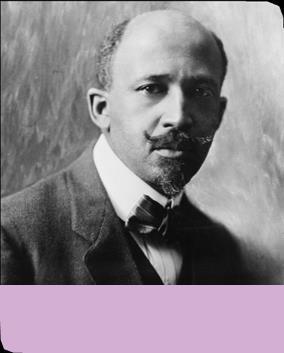
Civil Rights Activist, Educator, Journalist (1868 - 1963)
After earning his bachelor’s degree at Fisk, Du Bois entered Harvard University. After completing his master’s degree, he was selected for a study-abroad program at the University of Berlin; where he studied with some of the most prominent social scientists of his day and was exposed to political perspectives that he touted for the remainder of his life.
Du Bois became the first African American to earn a Ph.D. from Harvard University in 1895 and went on to enroll as a doctoral student at Friedrich-WilhelmsUniversität (now Humboldt-Universität). Not long after, Du Bois published his landmark study the first case study of an African American community; titled, The Philadelphia Negro: A Social Study (1899), marking the beginning of his expansive writing career. In that study, he coined the phrase “the talented tenth,” a term that described the likelihood of one in ten Black men becoming leaders of their race.
A proponent of Pan-Africanism, Du Bois helped organize several Pan-African Congresses to free African colonies from European powers. W.E.B. Du Bois died on August 27, 1963 one day before Martin Luther King Jr. delivered his, I Have a Dream speech at the March on Washington at the age of ninety-five, in Accra, Ghana, while working on an encyclopedia of the AfricanDiaspora.
Jesse Owens, also known as “The Buckeye Bullet,” was born September 12, 1913, in Oakville, Alabama. He was born the son of a sharecropper and the grandson of slaves. Although “Jesse” was a frail child and often sick from battles with chronic bronchial congestion and pneumonia, he was expected to work. At the early age of seven he was

“Jesse’s” thick southern accent, one of his instructors, believed the young athlete said his name was “Jesse,” when he in fact had said “J.C.” Owens’ athletic career began in high school, at the 1933 National Interscholastic Championships; quickly making a name for himself as a nationally recognized sprinter, setting records in the 100-yard and 200-yard dashes, and the long jump.
Thurgood Marshall born in Baltimore, Maryland, July 2, 1908; a descendant from slaves on both sides of his family. His original name was Thoroughgood, but he shortened it to Thurgood.
Marshall attended Frederick Douglass High School in Baltimore, and graduated a year early, in 1925, in the top third of the class. After high school, he attended Lincoln University, with other, now historians, poet Langston Hughes and musician Cab Calloway.

Judge, Civil Rights Activist, Supreme Court Justice, Lawyer (1908 - 1993)
There, he was suspended twice for hazing and pranks. In his second year Marshall participated in a sit-in protest segregation at a local movie theater and was initiated as a member of Alpha Phi Alpha, the first fraternity founded by and for Black people.
He married during his college years which encouraged him to take his studies seriously, He graduated from Lincoln with honors (cum laude).
Marshall wanted to study; but did not apply to his hometown school, the University of Maryland School of Law, because of the school’s segregation policy. He attended Howard University School of Law, where he worked harder than he had at Lincoln. Marshall graduated magna cum laude from Howard, in 1933.
In the 1936 Olympics, Hitler, criticized America for including Black athletes on its Olympic roster. But it was the African American participants who helped cement America’s success at the Olympic Games. In all, the United States won eleven gold medals, six of them by Black athletes. Owens captured four gold medals (the 100 meters, the long jump, the 200 meters and the 400 meters relay) and broke two Olympic records along theway.
While Owens helped the U.S. triumph at the games, his triumph did not travel with him upon his return home. President Franklin D. Roosevelt failed to meet with Owens and congratulate him, as was typical for champions. Owens would not be properly recognized until 1976, when President Gerald Ford awarded him the Presidential Medal of Freedom.
He established a private legal practice in Baltimore before founding the NAACP Legal Defense and Educational Fund, where he served as executive director. In that position, he argued several cases before the Supreme Court, including Smith v. Allwright, Shelley v. Kraemer, and Brown v. Board of Education, which held that racial segregation in public education is a violation of the Equal Protection Clause. In 1967, President Johnson nominated Marshall to serve on the United States Supreme Court. On October 2, 1967, Marshall was sworn in as a Supreme Court justice, becoming the first African American to serve on the nation’s highest court. As a Supreme Court justice, Marshall consistently supported rulings upholding a strong protection of individual rights and liberal interpretations of controversial social issues.
Throughout Marshall’s 24-year tenure on the Court, Republican presidents appointed eight consecutive justices, rendering Marshall an isolated liberal member of an increasingly conservative court. For the latter part of his time on the bench, Marshall was largely relegated to issuing strongly worded dissents, as the Court reinstated the death penalty and limited affirmative action measures and abortion rights. Marshall retired from the Supreme Court in 1991.
Thurgood Marshall died on January 24, 1993, at the age of 84.
Although born in Miami, Florida on February 20, 1927, during a mainland visit by his parents, Sidney Poitier, is a native of Cat Island, Poitier grew up in poverty as the son of a farmer. He had little formal education and at the age of fifteen was sent to Miami to live with his brother, to forestall a growing tendency toward delinquency. In the U.S., Poitier first experienced the racial chasm that divided the country. The poor treatment he received on the streets of Miami, gave birth to his determination to find and create opportunities for African Americans.
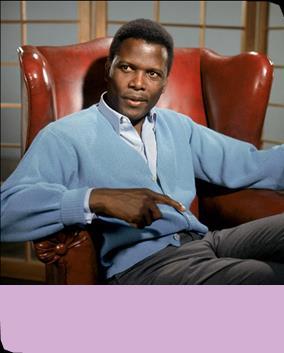
Actor, Director, Filmmaker (Born 1927)
At 18, he went to New York, did menial jobs, and slept in a bus terminal toilet. A brief stint in the Army was followed by more menial jobs in Harlem. An impulsive audition at the American Negro Theatre was rejected so forcefully that Poitier dedicated the next six months to overcoming his accent and performance ineptness. On his second try, he was accepted.
He was selected for a big part in a Broadway production of “Lysistrata,” for which he got excellent reviews. By the end of 1949, he had to choose between leading roles on stage and an offer to work for Darryl F. Zanuckin the film No Way Out (1950).
Seven years later, eventually recognized for his talents, he played several roles that catapulted him into a starring role as the lead man, a category rarely if ever achieved by an African American man of that time. The film, The Defiant Ones (1958), gave Poitier his first Academy Award nomination as Best Actor. Five years later, he won the Oscar for Lilies of the Field (1963), In 1964, Poitier became the first Bahamian and first Black actor to win an Academy Award for Best Actor, and the Golden Globe Award for Best Actor for his role in Lilies of the Field.
Poitier maintained activity on stage, on screen, and in the burgeoning Civil Rights movement. His roles in Guess Who’s Coming to Dinner (1967) and To Sir, with Love (1967) were for their time landmarks in the breaking down of social barriers between African Americans and whites, and Poitier’s talent, conscience, integrity, and inherent likability placed him on equal footing with the white stars of the day. He eventually took on the roles of directing and producing in the Seventies, achieving success in both arenas.
Although he has reduced the frequency of his roles in recent years, he remains one of the most respected and beloved figures in American cinema of the twentieth century.
Malcolm X was born Malcolm Little in Omaha, Nebraska, on May 19, 1925. His father was Earl Little, an outspoken Baptist minister; his mother, Louise Norton Little, a homemaker who cared for their eight children. After his father’s suspicious death, Malcolm’s mother had a nervous breakdown, and in 1939, she was committed to the State Mental Hospital, where she remained until her children secured her release 26 years later.
A smart student, his dream of being a lawyer was crushed when his favorite teacher told him it was “no realistic goal for a nigger.”

Civil Rights Activist, Minister (1925 - 1965
Malcolm lost interest in and dropped out of school. By 1942, Malcolm moved to Harlem, New York. After moving back to Boston, in 1946, he was arrested and convicted on burglary charges. He was sentenced to 10 years in prison but was paroled after serving seven. He used his time in prison to further his education by reading; and, copying an entire dictionary, to improve his handwriting. During a visit from his brother, Malcolm became interested in his brother’s newfound religion and began to study the teachings of the Nation of Islam (NOI) leader, Elijah Muhammad. Elijah Muhammad taught that white society strove to keep African Americans from empowering themselves to achieve political, economic, and social success. In 1952, released on parole, Malcolm became a devoted follower of Muhammad. He took a new surname; X, believing Little was a slave name. X signified his lost tribal name. Elijah Muhammad appointed Malcolm as a minister and national spokesperson for the Nation of Islam (NOI).
In 1958, Malcolm married Betty Shabazz in Lansing, Michigan. They had six daughters, all of whom took the surname Shabazz. Four were born before Malcolm’s death. A pair of twins were born after his death, in 1965.
In March 1964, Malcolm terminated his relationship with the NOI and started his own religious organization, the Muslim Mosque, Inc. The relationship between the two became volatile. Later that year, Malcolm went on a pilgrimage to Mecca in Saudi Arabia, which proved to be a life-changing journey. He received positive responses to his thoughts and beliefs from people of other cultures.
So, when Malcolm returned to the United States, he held a new outlook on the future. He began to speak to all races, not just African Americans.
In February 1965, Malcolm’s home was firebombed, but the family emerged unscathed. One week after the firebomb attempt, three gunmen rushed on stage, at a speaking engagement, and shot him at close range, 15 times. He was pronounced dead at a hospital on February 21, 1965.
Due to racial discrimination, African American service members were not allowed to learn to fly until 1941, when African American college graduates were selected for what the Army called, “an experiment,” the creation of the segregated 99th Fighter Squadron, which trained at an airfield adjacent to Alabama’s Tuskegee Institute. The experiment involved training Black pilots and ground support members. They originally formed the 99th Pursuit Squadron. The squadron, quickly dubbed the Tuskegee Airmen, was activated on March 22, 1941, and redesignated as the 99th Fighter Squadron on May 15, 1942. For every Black pilot there were 10 other black civilians, officers and enlisted men and women on ground support duty.
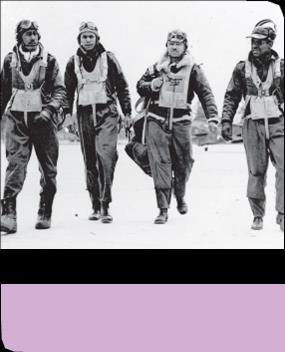
Charles Alfred Anderson, the first African American to earn his pilot’s license, became the first flight instructor when the Civilian Pilot Training Program (CPTP) was organized at Tuskegee Institute in October 1939. The army decided to model its training program on the CPTP and hired Anderson to teach the Tuskegee pilots.
When Eleanor Roosevelt visited Tuskegee Army Airfield in 1941, she insisted on taking a ride in an airplane with a black pilot at the controls; and, insisted that her flight with Charles Anderson, her pilot, be photographed and the film developed immediately so that she could take the photographs back to Washington when she left the field. Eleanor Roosevelt used this photograph as part of her campaign to convince FDR to activate the participation of the Tuskegee Airmen in North Africa and in the European Theater.
In June 1943, the Tuskegee Airmen entered combat over North Africa. The Airmen exemplified courage, skill, and dedication in combat. They flew P-39-, P-40-, P-47 and P-51 type aircraft in more than 15,000 sorties, completing over 1,500 missions during the war. No other escort unit could claim such a record.
When the war ended, the Tuskegee Airmen returned home with one hundred and fifty Distinguished Flying Crosses, Legions of Merit, and the Red Star of former Yugoslavia. The group was deactivated in May 1946, but its success would contribute to the eventual integration of the United States military. The fruit of the efforts of the airmen would be harvested in the eventual 1948 desegregation of the U.S. Armed Forces.
Rosa M. Parks was born in 1913, and She believed all people should be treated equally. Civil rights activist Rosa Parks was born February 4, 1913. Unintended, Rosa Parks became known as the “Mother of the Civil Rights Movement.” In 1960 she was arrested for refusing to give up her seat to a white man. Rosa recalled that her refusal was not because she was physically tired, but that she was tired of giving in. Her arrest led to a boycott of riding buses for one year and spurred on the 381-day Montgomery Bus Boycott that helped launch nationwide efforts to end segregation of public facilities.
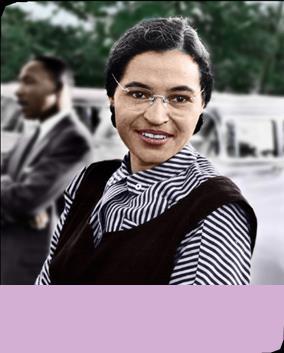
Her case ended up with the Supreme Court declaring segregation on public buses illegal. With the transit company and downtown businesses suffering economic loss and the legal system ruling against them, the city of Montgomery had no choice but to lift its enforcement of segregation on public buses. The boycott officially ended on December 20, 1956.
Although Rosa became a symbol of the Civil Rights Movement, she suffered hardship following her arrest in Montgomery and the subsequent boycott. She lost her job and her husband was fired. Unable to find work, they left Montgomery and moved to Detroit, Michigan. Rosa worked as a secretary and receptionist in U.S. Representative John Conyers’ congressional office. She served on the board of the Planned Parenthood Federation of America; and, in 1987, founded the Rosa and Raymond Parks Institute for Self-Development.
Rosa Parks received a number of accolades during her lifetime: the Spingarn Medal, the NAACP’s highest award and the prestigious Martin Luther King Jr. Award. In 1996, President Bill Clinton awarded Parks the Presidential Medal of Freedom, the highest honor given by the United States’ executive branch; and in 1997, she was awarded the Congressional Gold Medal, the highest award given by the U.S. legislative branch. TIME Magazine named her on its 1999 list of “The 20 Most Influential People of the 20th Century.” In 2000, Troy University created the Rosa Parks Museum. In 2001, the city of Grand Rapids, Michigan, consecrated Rosa Parks Circle, a 3.5-acre park. A biographical movie, The Rosa Parks Story, was released in 2002.
In celebration of what would have been Rosa Parks’ 100th birthday, a commemorative U.S. Postal Service stamp, called the Rosa Parks Forever, debuted. Later that month, President Barack Obama unveiled a statue of Parks in the nation’s Capitol building. He shared, “In a single moment, with the simplest of gestures, she helped change America and change the world. . .And today, she takes her rightful place among those who shaped this nation’s course.”
Rosa Parks died of natural causes on October 24, 2005, in Detroit Michigan.
Born in Cairo, Georgia, in 1919, Jack Roosevelt Robinson was the youngest of five children. Shortly after his birth, Jackie’s father, Jerry Robinson, left the family. The remaining Robinsons lived with racial discrimination on the Jim Sasser plantation.
In 1939, Robinson enrolled in the University of California, Los Angeles, where he became a football, basketball, track, and baseball star. During his first year at UCLA, Robinson met a young nursing student, Rachel Isum, whom he married on February 10, 1947, and had three children.

In 1941, Robinson left UCLA, without his degree, to play football for the semi-pro Honolulu Bears. Soon after, the Japanese attacked Pearl Harbor. On April 3, 1942, Jackie Robinson was inducted into the U.S. Army during World War II, later accepted into officer candidate school. He graduated, earning his second lieutenant’s bars on January 28, 1943, and was assigned to Fort Riley, Kansas. After experiencing intense racial discrimination, he was transferred to Fort Hood, Texas, for further training.
During this time, the baseball world consisted of a whites-only system. Blacks played in the “Negro Leagues,” which developed after 1900 as an alternative to the segregated white game. It was during his one-year stint with the Monarchs that Brooklyn Dodgers president, Branch Rickey, scouted him, and with some undercover persuasion, eventually signed Robinson to the team at the minimum of $5,000 per month. Robinson’s debut put him at first base with the Dodgers on April 15, 1947. In 1947, Robinson was named Rookie of the Year, and by 1949, he had received the Most Valuable Player (MVP) award for the National League. Out of the 10 years that Jackie Robinson played baseball, six of them were spent leading the Dodgers into the World Series. He was also a six-time All-Star.
On January 5, 1957, Robinson retired from the game he loved. With ambitions to either coach or manage in the Major leagues, he once again became a victim of discrimination. Robinson eventually served as an executive on the board of the National Association for the Advancement of Colored People (NAACP) until 1967, involving himself in various presidential elections, publicly expressing his stand on civil rights.
In 1962, Robinson became the first African American to be inducted into the Baseball Hall of Fame. On June 4, 1972, the Dodgers, and all Major League Baseball (MLB) teams, retired his uniform, No. 42; officially making the 15th of April Jackie Robinson Day, in honor of his April 15, 1947, debut game. At 53, Jackie Robinson died in Stamford, Connecticut, on October 24, 1972, of heart disease.
U.S. Olympic gold medalist Tommie Smith, and his teammate John Carlos, won bronze in the 200-meter race, raised their fists during the U.S. national anthem at the 1968 Summer Games in Mexico City.
Smith and Carlos (both of whom are National Track and Field Hall of Famers) were vilified at home for their stand. They were suspended from the U.S. team, and they received death threats; but neither man ever apologized for his raised fist or his bowed head and neither ever had need to. For both men, the protest was done because of a need, done because of a pride in a system, a system of social change…it represented those who did not have a platform. It represented those who did not have a word. It represented those that had stories that needed to be told.

Smith and Carlos had taken a stand at a moment when the country was also embroiled in protests over the Vietnam War and the aftermath of the assassinations of Martin Luther King Jr. and Robert F. Kennedy. The nation had seen on television Chicago police beating demonstrators at the Democratic National Convention. They had one pair of gloves between them. Smith put a black glove on his right fist; Carlos covered his left fist. Smith raised his right fist, Carlos his left. Their gesture was a show of defiance against oppression taking place at the height of the civil rights struggle in America.
The protest had been something the two athletes carefully planned. As Smith and Carlos walked to the podium, they took off their shoes to protest poverty. They wore beads and scarves to protest lynchings. The right hand in the air with the black glove represented power and tranquility; and of course, the head bow was a prayer. It was a prayer of hope, a prayer of saneness, a prayer for equality. When the national anthem was played, they lowered their heads in defiance and raised their fists in a Black Power salute that rocked the world.
After their track careers, both Smith and Carlos played in the NFL, but their time on the field was short-lived. Smith played three seasons with the Cincinnati Bengals, according to the Track and Field Hall of Fame. Carlos played one year with the Philadelphia Eagles and one year in the Canadian Football League.
Smith also worked at Santa Monica College as a sociology professor and head crosscountry and track and field coach.
Wilma Rudolph was born prematurely on June 23, 1940, in St. Bethlehem, TN.,
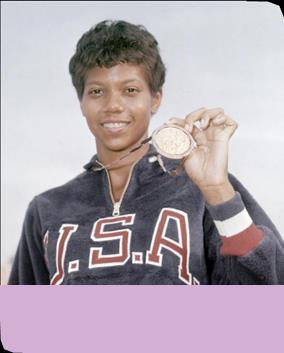
9 and soon became a budding basketball star. At the all African American Burt High School, Rudolph played on the girls’ basketball team, where her coach, C.C. Gray, gave her the nickname, “Skeeter.” Rudolph became an all-state player, setting a state record of forty-nine points in one game.
At the request of Ed Temple, the Tennessee State track coach, Rudolph’s basketball coach, C.C. Gray, formed a girls track team. Presumably, Ed Temple saw Wilma’s speed on the basketball court and wanted to turn her into a sprinter.
Wilma loved it enough to begin attending Temple’s daily college practices while still in high school. She had a natural ability that not even she could explain. “I don’t know why I run so fast,” she said. “I just run.”
At the 1960 Rome Olympics, Rudolph became “the fastest woman in the world” and the first American woman to win three gold medals in one Olympics. She won the 100-meter and 200-meter races and anchored the U.S. team to victory in the 4 x 100-meter relay, breaking records along the way.
Eunice Kathleen Waymon was born on February 21, 1933, in Tryon, North Carolina. A precocious child, she played piano and organ in girlhood. She became sensitive to racism when at age 12 she gave a piano recital in a library where her parents had to stand in the back because they were Black.
Nina studied classical music at the Juilliard School of Music in New York City. Simone taught piano and worked as an accompanist for other performers while at Juilliard, but she eventually had to leave school after she ran out of funds.

Musician, Author, Singer, Pianist, Civil Rights Activist (1933 - 2003)
Her vocal career began in 1954 in an Atlantic City, N.J., nightclub when the club owner threatened to fire her unless she sang too. At this time, now 21 years old, Eunice Kathleen Waymon, was going by a different name on her nightly Atlantic City gig: Nina Simone. She hoped that adopting a different name would keep her mother from finding out about her performances. “Nina” was her boyfriend’s nickname for her at the time. “Simone” was inspired by Simone Signoret, an actress that the singer admired.
Performing in night clubs, she turned her interest to jazz, blues and folk music and released her first album in 1957, scoring a Top 20 hit with the track "I Loves You Porgy” which became a 1959 hit.
In the 1960s she added protest songs, became a friend of Martin Luther King, Jr., and Malcolm X, and performed at civil rights demonstrations. Originally noted as a jazz singer, she became a prominent voice of the 1960s civil rights movement with recordings such as “Mississippi Goddam” and “Old Jim Crow”; her best-known composition was “To Be Young, Gifted and Black.” Her popularity grew as she added folk and gospel selections as well as songs by the Bee Gees, Bob Dylan, and Screaming Jay Hawkins (“I Put a Spell on You”), to her repertoire.
Rudolph especially inspired young African American female athletes. Most notable was Florence Griffith Joyner, the next woman to win three gold medals in one Olympics (1988). Rudolph was voted into the Black Athletes Hall of Fame in 1973 and the National Track and Field Hall of Fame in 1974. NBC made a movie about her life from her autobiography,“Wilma.”
Rudolph died of brain cancer at age 54 on Nov. 12, 1994, in Nashville. Her extraordinary calm and grace are what people remember most about her.
Angered by American racism, she left the United States in 1973 and lived in Barbados, Africa, and Europe for the rest of her life. Like her private life, her career was turbulent, she experienced major mental health and financial issues, and she gained a reputation for throwing onstage tantrums, insulting inattentive audiences, and abruptly canceling concerts. A 1980s Chanel television commercial that included her vocal “My Baby Just Cares for Me” helped introduce her to many new, younger listeners, resulting in a resurgence in her career. Despite ill health, she continued to tour and perform, and she maintained a devoted international following to the end. Simone died in France on April 21, 2003.
Fannie Lou Hamer was a civil rights activist whose passionate depiction of her own suffering in a racist society helped focus attention on the plight of African Americans throughout the South.
Born Fannie Lou Townsend on October 6, 1917, in Montgomery County, Mississippi. The daughter of sharecroppers, Hamer began working the fields at an early age.
Her family struggled financially and often went hungry.
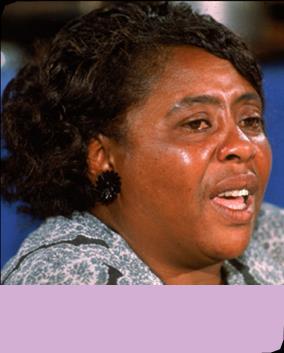
Activist, Philanthropist, Civil Rights Activist (1917 - 1977
Married to Perry “Pap” Hamer in 1944, Fannie Lou continued to work hard just to get by. In the summer of 1962, she made a life-changing decision to attend a protest meeting. She met civil rights activists there who were there to encourage African Americans to register to vote. Hamer became active in helping with the voter registration efforts.
Hamer also dedicated her life to the fight for civil rights, working for the Student Nonviolent Coordinating Committee (SNCC). This organization was comprised mostly of African American students who engaged in acts of civil disobedience to fight racial segregation and injustice in the South. These acts were often met with violent responses by angry whites. During the course of her activist career, Hamer was threatened, arrested, beaten, and shot at; but none of these things ever deterred her from her work.
In 1964, Hamer helped found the Mississippi Freedom Democratic Party, which was established in opposition to her state’s all-white delegation to that year’s Democratic convention. She brought the civil rights struggle in Mississippi to the attention of the entire nation during a televised session at the convention. The next year, Hamer unsuccessfully ran for Congress in Mississippi.
Hamer set up organizations to increase business opportunities for minorities and to provide childcare and other family services. Hamer died of cancer on March 14, 1977, in Mound Bayou, Mississippi. Fannie Lou Hamer's tombstone in her hometown of Ruleville, Mississippi is inscribed with her famous quote, "I am sick and tired of being sick and tired."
Muhammad Ali, was born Cassius Clay, on January 17, 1942, in Louisville, KY. He began training as an amateur boxer when he was 12 years old. At age 18, he won a gold medal in the light heavyweight division at the 1960 Summer Olympics in Rome and turned professional later that year. At age 22 in 1964, he won the WBA, WBC, and lineal heavyweight titles from Sonny Liston in a major upset.
Shortly after, Clay converted to Islam and changed his name from Cassius Clay, which he called his “slave name”, to Muham- mad Ali. He set an example of racial pride for African Americans and resistance to white domination during the Civil Rights Movement.

Philanthropist (1942 - 2016)
Two years after winning the heavyweight title, Ali refused to be drafted into the U.S. military, citing his religious beliefs and opposition to American involvement in the Vietnam War. He was eventually arrested, found guilty of draft evasion, and stripped of his boxing titles. He successfully appealed the decision to the U.S. Supreme Court, who overturned his conviction in 1971. He lost four years of peak performance as an athlete. Ali’s actions as a conscientious objector to the war made him an icon for the larger counterculture generation of the 1960’s.
Ali is regarded as one of the leading heavyweight boxers of the 20th century and remains the only three-time lineal heavyweight champion. During 1964, Ali reigned as the undisputed heavyweight champion. His records of the most wins in heavyweight title bouts and most wins in unified championship bouts in modern boxing history were unbeaten for 35 and 38 years, respectively.
Ali is the only boxer to be named The Ring magazine Fighter of the Year, six times. He was also ranked as the greatest athlete of the 20th century by Sports Illustrated, the Sports Personality of the Century by the BBC, and the third greatest athlete of the 20th century by ESPN Sports Century. Nicknamed “the Greatest,” he participated in several historic boxing matches.
Muhammad Ali had a career record of fifty-six wins, five losses and thirty-seven knockouts be- fore his retirement from boxing, in 1981, at the age of thirty-nine. Ali was a professional boxer as well as an activist, donating much of his earnings to various charities. He will always be remembered as the boxer who could “float like a butterfly and sting like a bee.” Muhammad Ali died June 3, 2016, in Scottsdale, Arizona.
The “Godfather of Soul,” James Brown, was born James Joe Brown Jr. on May 3, 1933, in a one-room shack in the woods of Barnwell, South Carolina. Growing up in abject poverty during the Great Depression, a young Brown worked whatever odd jobs he could find, for pennies.
Brown recalls his impoverished childhood, “I started shining shoes at 3 cents, then went up to 5 cents, then 6 cents. I never did get up to a dime. I was 9 years old before I got a pair of underwear from a real store; all my clothes were made from sacks and things like that. But I knew I had to make it. I had the determination to go on, and my determination was to be somebody.”

Dancer, Activist, Singer, Songwriter, Musician (1933 - 2006)
Born on April 25, 1917, in Newport News, Virginia, Ella Fitzgerald was the product of a common-law marriage between William Fitzgerald and Temperance “Tempie” Williams Fitzgerald. Ella Fitzgerald turned to singing after a troubled childhood and debuted at the Apollo Theater in 1934.
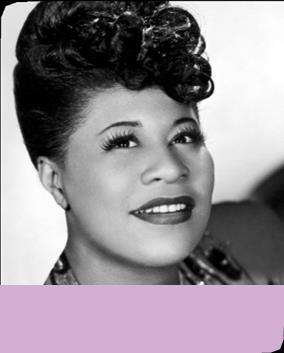
Brown turned to religion and to music as an escape from the harsh reality of growing up black in the rural South during the Great Depression. As a teenager he also turned to crime. At 16, he was arrested for stealing a car and sentenced to three years in prison. While incarcerated, Brown organized and led a prison gospel choir and met Bobby Byrd, an aspiring R&B singer and pianist, forming a friendship and musical partnership that proved one of the most fruitful in music history.
Brown was released from prison in 1953. He turned his attention to sports and devoted the next two years to boxing and playing semiprofessional baseball. In 1955, Bobby Byrd invited Brown to join his R&B vocal group, The Gospel Star- lighters, later name the Famous Flames. In 1956, the Famous Flames recorded a song “Please, Please, Please.” It reached No. 6 on the R&B charts.
Brown toured relentlessly, performing five or six nights a week, earning the title “The Hardest-Working Man in Show Business.” He was a flashy entertainer, incredible dancer, and soulful singer. He recorded many of his most popular and enduring singles during the mid-1960s, when he also began devoting more energy to social causes.
In 1966, he recorded “Don’t Be a Dropout,” an eloquent and impassioned plea to the Black community to place more focus on education. On April 5, 1968, the day after Martin Luther King Jr.’s assassination, with riots raging across the country, Brown gave a rare televised live concert in Boston, preventing rioting there. A few months later he wrote and recorded “Say It Loud: I’m Black and I’m Proud,” a protest anthem that has unified and inspired generations.
In 1986, Brown was one of the first musicians inducted into the Rock and Roll Hall of Fame the year of its inception. James Brown passed away on December 25, 2006, after a weeklong battle with pneumonia. He was 73 years old.
After tumultuous teenage years, Fitzgerald found stability in musical success with the Chick Webb Orchestra, performing across the country, but most often associated with the Savoy Ballroom in Harlem. Fitzgerald’s rendition of the nursery rhyme “A-Tisket A-Tasket,” helped boost both her and Webb to national fame. In 1942, Fitzgerald began a solo career that would effectively last the rest of her life.
An American jazz singer often referred to as the First Lady of Song, Queen of Jazz, and Lady Ella. She was noted for her purity of tone, impeccable diction, phrasing, intonation, and a “horn-like” improvisational ability, particularly in her scat singing. Ella Fitzgerald is one of the greatest scat singers in jazz history.
Fitzgerald made her film debut as Ruby in the 1942’s comedy western Ride ‘Em Cowboy with Bud Abbott and Lou Costello. Her career really began to take off in 1946 when she started working with Norman Granz, the future founder of Verve Records.
Ella Fitzgerald recorded some of her more widely noted works, with Verve Records, particularly her interpretation of the Great American Songbook. Fitzgerald’s musical collaborations with Louis Armstrong, Duke Ellington, and The Ink Spots were some of her most notable acts outside of her solo career. These partnerships produced recognizable songs like “Dream a Little Dream of Me,” “Cheek to Cheek,” “Into Each Life Some Rain Must Fall,” and “It Don’t Mean a Thing (If It Ain’t Got That Swing).”
In 1958, Fitzgerald made history as the first African-American woman to win a Grammy Award. She would go on to win 13 Grammys and sell more than forty million albums. In 1993, Fitzgerald capped off her fifty-nine-year career with her last public performance. Three years later, in 1996, she died at the age of seventy-nine, following years of decline in her health. After her death, Fitzgerald’s influence lived on through her fourteen Grammy Awards, National Medal of Arts, Presidential Medal of Freedom, and tributes in the form of stamps, music festivals, and theater namesakes.
Coretta Scott was born on April 27, 1927, in Marion, Alabama. In the early decades of her life, Coretta was as well known for her singing and violin playing as her civil rights activism. She attended Lincoln High School, graduating as the school’s valedictorian in 1945, and then enrolled at Antioch College in Yellow Springs, Ohio, receiving her Bachelor of Arts in music and education in 1951.
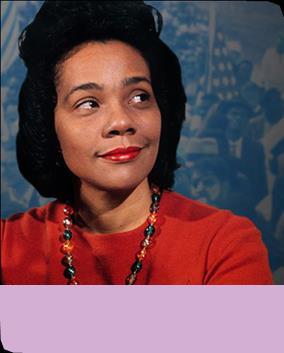
Writer, Activist (1927 - 2006)
Coretta was awarded a fellowship to the New England Conservatory of Music in Boston, Massachusetts, where she met soon-to-be famed civil rights leader Martin Luther King Jr., then a doctoral candidate at Boston University’s School of Theology. They married on June 18, 1953, at her family home in Marion.
After earning her degree in voice and violin from NEC in 1954, Coretta moved with her husband to Montgomery, Alabama.
Though best known for working alongside her husband, Coretta established a distinguished career in activism in her own right. Among many roles, she worked as a public mediator and as a liaison to peace and justice organizations.
Working side by side with her husband throughout the 1950s and 1960s, Coretta took part in the Montgomery Bus Boycott of 1955, journeyed to Ghana to mark that nation’s independence in 1957, traveled to India on a pilgrimage in 1959 and worked to pass the 1964 Civil Rights Act, among other endeavors.
In the aftermath of her husband’s assassination, Coretta founded the Martin Luther King Jr. Center for Nonviolent Social Change, serving as the center’s president and chief executive officer from its inception. After spurring the formation of what became the Martin Luther King Jr. National Historic Site, around his birthplace in Atlanta, she dedicated the new King Center complex on its grounds in 1981.
Coretta Scott King suffered a heart attack and stroke in August 2006. She died less than six months later, on January 30, 2006, while seeking treatment for ovarian cancer at a clinic in Playas de Rosarito, Mexico. She was 78 years old.
Born in Atlanta, Georgia on January 15, 1929, Martin Luther King became synonymous with the civil rights movement. He dedicated his life to addressing this situation through non-violent means until his untimely death in 1968.
He was raised by a family of preachers and became assistant to his father at the Ebenezer Baptist Church in his hometown of Atlanta. He was college educated and started his first semester at Morehouse College when he was just 15 years old. He attended Crozer Theological Seminary in Pennsylvania and later went on to get his Ph.D. in theology from Boston University. While he was attending school in Boston, Martin Luther King, Jr. met Coretta Scott. The two married at the home of Coretta’s parents and they raised a family of four children.
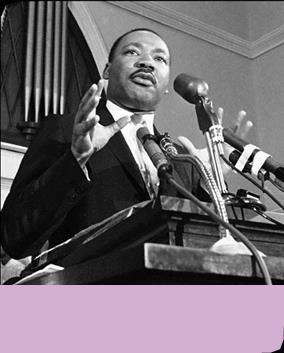
His active participation in the civil rights movement began with the Montgomery bus boycott inspired by Rosa Parks. He organized the Southern Christian Leadership Conference and used it to lecture on race-related topics. Dr. King used the media to spread the word and his participation in sit-ins and protests landed him in jail on more than one occasion. One of his most profound writings came through his letter from the Birmingham jail.
In 1963, he took part in the historic March on Washington. More than 200,000 peaceful participants gathered at the Lincoln Memorial and listened as MLK Jr. delivered his famous, “I Have a Dream” speech.
In 1964, Dr. Martin Luther King was the youngest recipient of the Nobel Peace Prize for his unrelenting work in the civil rights movement. He led 1,500 Black and white people on a march outside of Selma to bring attention to the social injustices that were going on at that time. When the group was met by a wall of state troopers, King led his group to a prayer session avoiding further confrontation with authorities.
When changes began happening in the civil rights movement, Dr. King turned his attentions to poor people and the Vietnam War. But it was not long before Martin Luther King Jr.'s life came to an abrupt end when he was assassinated in Memphis Tennessee on April 4, 1968.
Best known for her autobiographical writings, I Know Why the Caged Bird Sings and All God’s Children Need Traveling Shoes, Maya Angelou was nominated for a Pulitzer Prize for her volume of poetry, Just Give Me a Cool Drink of Water ‘Fore I Die.
Born in St. Louis, Missouri, on April 4, 1928, and named Marguerite Johnson. Her nickname, Maya, originated from her brother.
At age seven, Maya was raped by her mother’s boyfriend. Her brother persuaded her to tell him who raped her. Shortly after, the man was murdered. Maya thought that because she let on, it was her fault he was murdered, so she refused to speak to anyone, except her brother, for four years.
Actress, Author (1928 - 2014)

In 1945, Maya graduated from George Washington high school in San Francisco and became a single mother shortly afterward. To support her son, she danced in night clubs, cooked at a Creole cafe, and removed paint at a body shop.
Maya became the first African American woman to conduct cable cars in San Francisco.
In 1953, and no longer married to Tosh Angelos, Maya changed her surname to Angelou, for a stage name while performing at a San Francisco night club.
In 1959, Angelou moved to Brooklyn, New York, to join the Harlem Writers Guild. That year she became the northern coordinator of the Southern Christian Leadership Conference (SCLC), at the request of Martin Luther King Jr. From 1961 to 1962, Angelou was the associate editor of the only English-language news weekly in the Middle East, the Arab Observer, in Cairo, Egypt. From 1964 to 1966, she was the feature editor of the African Review in Accra, Ghana.
Returning to the U.S. in 1970 she was appointed to the Bicentennial Commission by President Gerald R. Ford. She was later named to the Commission for International Woman of the Year by President Jimmy Carter.
Angelou’s book, I Know Why the Caged Bird Sings, which chronicled her life up to age 16, was published with tremendous success in 1970. She became the first African American female director in Hollywood. Her directorial debut was the film All Day Long in 1974. Angelou was nominated twice for Tony awards, for her Broadway acting debut in Look Away in 1973, and for her performance in the miniseries Roots in 1977.
At the request of President-elect Bill Clinton, she read her poem, “On the Pulse of the Morning,” at his inauguration in 1993. Maya Angelou died on May 28, 2014, at her home in Winston-Salem, North Carolina.
A pioneering and controversial civil rights leader, Jesse Jackson, was born as Jesse Louis Burns on October 8, 1941, in Greenville, South Carolina.
As a young fellow, Jackson’s biological father would recall that he always seemed kind of special. “Jesse was an unusual kind of fella, even when he was just learning to talk,” Noah Robinson told The New York Times in 1984. “He would say he is going to be a preacher. He would say, ‘I’m going to lead people through the rivers of the water.’” In school, Jackson was a good student and an exceptional athlete. He was elected class president, and in the fall of 1959, he attended the University of Illinois on a football scholarship.

In 1964 Jackson graduated from college with a degree in sociology. The next year he went to Selma, Alabama, to march with Dr. Martin Luther King, Jr., eventually becoming a worker in King’s Southern Christian Leadership Conference (SCLC).
In 1966, he moved his young family to Chicago, where he did graduate work at the Chicago Theological Seminary. Jackson never finished his studies but was later ordained by the minister of a Chicago church. In 1966, he founded Operation PUSH (People United to Save Humanity). Jackson created the organization to advocate for self-help for Blacks.
In 1984, Jackson established the National Rainbow Coalition, whose mission was to establish equal rights for African Americans, women, and homosexuals. The two organizations merged in 1996 to form the Rainbow/PUSH Coalition. In 1984, Jesse Jackson became the second African American (Shirley Chisholm preceded him) to make a national run for the U.S. presidency. The campaign was historic in terms of its success. Jackson placed third in the Democratic primary voting and garnered a total of 3.5 million votes, surpassing Chisholm’s ballot success.
In 1988, Jackson finished second in the Democratic primaries to Massachusetts Governor Michael Dukakis, winning more than seven million votes. Later declining to run for the U.S. presidency again.
In 2000, President Clinton awarded Jackson the Presidential Medal of Freedom. That same year he received a Master of Divinity degree from the Chicago Theological Seminary. On November 17, 2017, Jackson revealed that he had been diagnosed with Parkinson’s disease.
Born in Transkei, South Africa on July 18, 1918, his father was Hendry Mphakanyiswa of the Tembu Tribe. Mandela was educat- ed at University College of Fort Hare and the University of Witwatersrand where he studied law. He joined the African National Congress (ANC) in 1944 and was engaged in resistance against the ruling National Par- ty’s apartheid policies after 1948. He went on trial for treason in 1956-1961 and was acquitted in 1961.
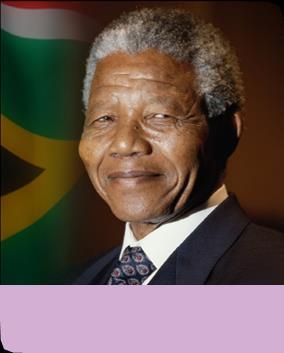
Activist, President of South Africa (1918 - 2013)
After the banning of the ANC in 1960, Nelson Mandela argued for the setting up of a military wing within the ANC. In June 1961, the ANC executive considered his proposal on the use of violent tactics and agreed that those members who wished to involve themselves in Mande- la’s campaign would not be stopped from doing so by the ANC. This led to the formation of Umkhonto we Sizwe.
Mandela was arrested in 1962 and sentenced to five years’ imprisonment with hard labour. In 1963, when many fellow leaders of the ANC and the Umkhonto we Sizwe were arrested, Mandela was brought to stand trial with them for plot- ting to overthrow the government by violence. On June 12, 1964, eight of the accused, including Mandela, were sentenced to life imprisonment. From 1964 to 1982, he was incarcerated at Robben Island Prison, off Cape Town; thereafter, he was at Pollsmoor Prison, nearby on the mainland.
During his years in prison, he was widely accepted as the most significant black leader in South Africa and became a symbol of resistance as the anti-apartheid movement gathered strength. He consistently refused to compromise his politi- cal position to obtain his freedom.
Nelson Mandela was released on February 11, 1990. After his release, in 1991, at the first national conference of the ANC held inside South Africa, Mandela was elected President of the ANC while his lifelong friend and colleague, Oliver Tambo, became the organization’s National Chairperson.
Nelson Mandela died at his home in Johannesburg, South Africa, on December 5, 2013, at the age of 95.
Aretha Franklin, “Queen of Soul,” was born in Memphis, Tennessee, in 1942, to Baptist preacher Reverend Clarence La Vaughan "C. L." Franklin and Barbara Siggers Franklin, a gospel singer. A gifted singer and pianist, Franklin toured with her father’s traveling re- vival show and later visited New York, where she signed with Columbia Records.
Aretha Franklin’s musical gifts became ap- parent at an early age. Largely self-taught, she was regarded as a child prodigy. A gifted pianist with a powerful voice, Franklin got her start singing in front of her father’s congregation.
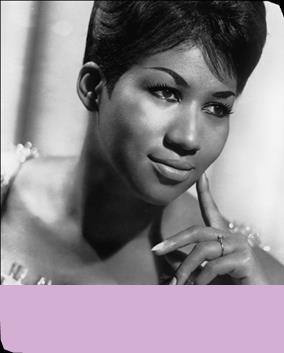
(1942-2018)
By the age of 14, she had recorded some of her earliest tracks at his church, which were released by a small label as the album Songs of Faith in 1956. She also performed with C. L.’s traveling revival show where she befriended gospel greats such as Mahalia Jackson, Sam Cooke and Clara Ward.
In 1960, Franklin traveled to New York, where she signed with Columbia Records, in 1961. Hitting her stride in 1967 and 1968, Franklin churned out a string of hit singles showcasing Franklin’s powerful voice and gospel roots in a pop framework. In 1967, the album I Never Loved a Man (The Way I Love You) was released, and the first song on the album, “Respect” reached No. 1 on both the R&B and pop charts and won Aretha her first two Grammy Awards. Franklin’s chart dominance soon earned her the title Queen of Soul, while also became a symbol of black empowerment during the civil rights movement of the time. In 1968, Franklin performed, “Precious Lord,” at the funeral of Dr.
Martin Luther King Jr. In the same year, she was also selected to sing the na- tional anthem to begin the Democratic National Convention. In 1985, Franklin’s smash-hit album: Who’s Zoomin’ Who? Featuring the single “Freeway of Love,” became Aretha’s biggest-selling album yet.
With 18 Grammys under her belt, Franklin is one of the most honored artists in Grammy history, In 1987, she became the first female artist to be inducted into the Rock and Roll Hall of Fame.
In 2003, Franklin released her final studio album on Arista, So Damn Happy. In 2005, she was awarded the Presidential Medal of Freedom and became the second woman ever to be inducted into the UK Music Hall of Fame.
Diane Earnestine Earle Ross was born on March 26, 1944, in Detroit, Michigan. She began singing with friends as a teenager, and eventually formed the groundbreaking 1960s trio the Supremes (later named Diana Ross and The Supremes), going on to have hits like “Come See About Me” and “You Can’t Hurry Love.”
The group was signed to Motown Records by famed producer and label founder Berry Gordy Jr. In 1961, the Supremes scored their first No. 1 hit with “Where Did Our Love Go?” (1964).

The trio then broke music records by having a streak of four additional singles top the charts “Baby Love” (1964), “Come See About Me” (1964) “Stop! In the Name of Love” (1965) and “Back in My Arms Again” (1965) thus becoming the first U.S. group ever to have five songs in a row to reach No 1. In all the group scored 12 No. 1 hits, including “I Hear a Symphony” (1965), “You Can’t Hurry Love” (1966), “The Happening” (1967), “Love Child” (1968) and “Someday We’ll Be Together” (1969); becoming the American vocal group with the most Billboard chart toppers in history.
Ross left the Supremes for a solo career in 1969 and continued to be a musical mainstay the following year with the Top 20 “Reach Out and Touch Somebody’s Hand” and the No. 1 “Ain’t No Mountain High Enough.”
She starred in the films Mahogany and Lady Sings the Blues as well, earning an Oscar nomination for the latter.
Despite her personal and professional difficulties, Ross has withstood the test of time, as a performer, with a career that spans more than four decades. She’s won several major awards, including a Golden Globe, a Tony and several American Music Awards; and was inducted into the Rock and Roll Hall of Fame in 1988 as part of the Supremes. In 2007, she was presented with Black Entertainment Television’s Lifetime Achievement Award. In the same year, Ross was honored by the Kennedy Center for her contributions to the arts. In 2012, Ross received her first-ever Grammy Award for Lifetime Achievement; despite having been nominated twelve times. Four years later, Ross received the Presidential Medal of Freedom from Barack Obama, the nation’s highest civilian honor. In 2017, she added to her collection with Lifetime Achievement honors at the American Music Awards.
Ray Charles Robinson was born on September 23, 1930, in Albany, Georgia. His father, a mechanic, and his mother, a sharecropper, moved the family to Greenville, Florida when he was an infant.
After witnessing the drowning death of his younger brother, Charles gradually began to lose his sight. He was blind, by age 7. His mother sent him to, the Florida School for the Deaf and the Blind, in Florida; there, he learned to read, write, and arrange music in Braille. He also learned to play piano, organ, sax, clarinet, and trumpet.
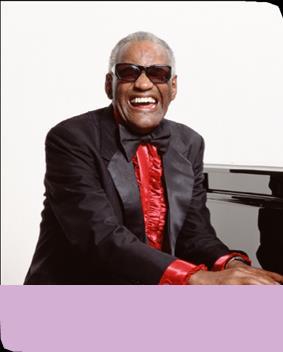
His musical interests ranged widely, from gospel, to country, to blues.
Charles’s mother died when he was fifteen, and for a year he toured on the “Chitlin’ Circuit” in the South. At the of age 16, Charles moved to Seattle, where he met a young Quincy Jones, a friend and collaborator he would keep for the rest of his life.
In 1949, he released his first single, “Confession Blues.” The song did well on the R&B charts. Subsequent success on the R&B charts followed with “Baby Let Me Hold Your Hand” and “Kissa Me Baby.” By 1953, Charles landed a deal with Atlantic Records. He released his first R&B hit single with the label, “Mess Around.” A year later, Charles’s now classic song, “I Got a Woman,” reached No. 1 on the R&B charts.
Ray Charles was a legendary musician who pioneered the genre of soul music during the 1950s. Charles integrated R&B, gospel, pop, and country to create groundbreaking hits. A blind genius, he is considered one of the greatest artists of all time. Fellow musicians began to call Charles “The Genius.” He also earned the nickname, “Father of Soul.” His biggest success was his ability to cross over into pop music too, reaching No. 6 on the pop chart and No. 1 on the R&B chart with his hit “What’d I Say.”
He earned his first Grammy Award for “Georgia on My Mind,” followed by two more for the singles “Hit the Road, Jack,” and his rendition of Stevie Wonder’s “Living for the City.” Charles broke down the boundaries of music genres in 1962 with Modern Sounds in Country and Western Music. On this album, he gave his own soulful interpretations of many country classics. Three years later, he released his autobiography Brother Ray.
During his lifetime, Charles recorded more than 60 albums and performed more than 10,000 concerts. Charles died on June 10, 2004, at his home in Beverly Hills, California.
Louis Armstrong was born on August 4, 1901. and raised in New Orleans, Louisiana. Coming to prominence in the 1920s as an “inventive” trumpet and cornet player.
Armstrong is renowned for his charismatic stage presence and voice as much as for his trumpet playing. Armstrong’s influence extends well beyond jazz, and by the end of his career in the 1960s, he was widely regarded as a profound influence on popular music in general.
He demonstrated great dexterity as an improviser, with his ability to bend the lyrics and melody of a song for expressive purposes. He was also very skilled at scat singing, improvised jazz singing in which the voice is used in imitation of an instrument.
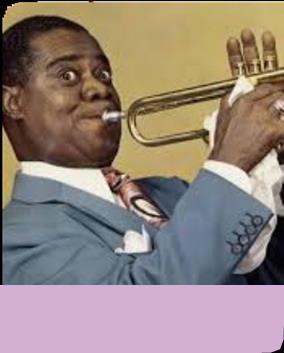
Tina Turner was born Anna Mae Bullock on November 26, 1939, in Nutbush, Tennessee. Her parents, Floyd, and Zelma Bullock, were poor sharecroppers, who, early in her life, split up and left Turner and her sister to be raised by their grandmother, returning to live with her mother, only, after her grand- mother died.
Barely in her teens, Turner quickly immersed herself in St. Louis’s R&B scene. In 1956, she met rock-and-roll pioneer Ike Turner, whom she would later marry and rear four children. Soon, Turner was performing with Ike’s group, Kings of Rhythm.
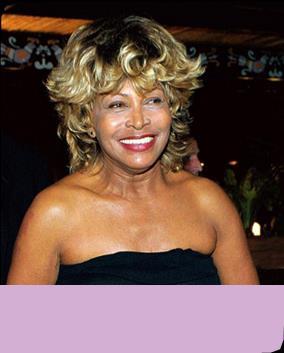
His career spanned five decades, from the 1920s to the 1960s. In 2017, he was inducted into the Rhythm & Blues Hall of Fame.
Armstrong’s skin color was secondary to his music in an America that was extremely racially divided at the time. He was one of the first hugely popular African American entertainers to “crossover”. Although he rarely publicly politicized his race, often to the dismay of fellow African Americans, he took a well-publicized stand for desegregation in the Little Rock crisis.
Armstrong died of a heart attack in his sleep on July 6, 1971, a month before his 70th birthday.
In 1960, Turner sang the lead on a track titled “A Fool in Love.” The song became a huge R&B success and soon crossed over to the pop charts. Before long, the group was touring as the Ike and Tina Turner Revue and earning renowned acclaim for their electrifying stage performances. Their popularity was rekindled in 1971 with the release Revival track “Proud Mary” that reached the top 5 of the U.S. charts and won Ike and Tina their first Grammy.
Despite their success as a musical duo, Tina later revealed that Ike was often physically abusive. By the mid-1970s, the couple separated both personally and professionally. In 1978, they were officially divorced.
In 1983, Turner’s solo career finally gained steam when she recorded a remake of Al Green’s “Let’s Stay Together.” In 1984, she exploded back into the record industry when Private Dancer was released. It won four Grammy Awards and eventually sold more than twenty million copies worldwide. Its single, “What’s Love Got to Do with It” reached No. 1 on the U.S. pop charts, earning the Grammy for Record of the Year.
Tina made her first film debut in 1975, playing the “Acid Queen” in Who’s Tommy; returning to the screen in 1986. One year later, she published her autobiography, I, Tina, later adapted as the 1993 film, What’s Love Got to Do with It. Tina Live in Europe followed in 1988 and won the Grammy for Female Rock Vocal Performance.
In 1991, Ike and Tina Turner were inducted into the Rock and Roll Hall of Fame. In 2008, she announced her final tour, “Tina! 50th Anniversary Tour,” which became one of the highest-selling ticketed shows of 2008 and 2009. She announced that it would be her final tour, and essentially retired from the music business save for occasional appearances and recordings. Turner was honored with a Lifetime Achievement Award from the Grammys in 2018.
Born in 1971 in Dallas, Texas, Erykah Badu, born Erica Abi Wright (she would later choose the moniker Erykah Badu; ”kah” is an Egyptian term for one’s “inner self,” and “badu” is her favorite jazz-riff scat sound), was exposed to the arts early on, and eventually began to perform in shows at the local Dallas Theater Center.
In 1996, Badu’s demo caught the attention of music producer Kedar Massenburg, who signed her and paired her with D’Angelo to record the song “Your Precious Love.”
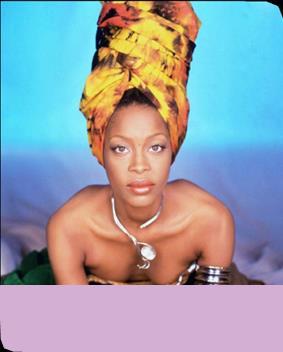
Kedar Entertainment later merged with Uni- versal Motown. Today, Badu is best known for her soulful music style, which is showcased on albums such as the Grammy Award-winning Baduizm.
Badu’s debut album, Baduizm, exploded onto the music scene in 1997 with soulful hits such as “On & On,” “Next Lifetime” and “Appletree.” The album marked a shift in the music of its time and began what was labeled a “neo- soul” movement. Baduizm received critical acclaim and won Badu two Grammy Awards, for best female R&B vocal performance and best R&B album.
In 2003, Badu also gave back to the community in which she had grown up by transforming the dilapidated Black Forest Theater in downtown Dallas into a space for charity events and theater. It would also serve as the offices for her nonprofit, B.L.I.N.D. (Beautiful Love Incorporated Nonprofit Development), which she founded in 1997 as a means of bringing culture and arts to inner-city areas to cultivate change.
Stevie Wonder was born Stevland Hardaway Judkins on May 13, 1950, in Saginaw, Michigan. He was born six weeks early with retinopathy of prematurity, an eye disorder which was exacerbated when he received too much oxygen in an incubator, leading to blindness.
Wonder showed an early gift for music, first with a church choir in Detroit, Michigan, where he and his family had moved when he was four years old, and later with a range of instruments, including the harmonica, piano and drums, all of which he taught himself before age 10. The diligent Wonder, who would go on to study classical piano, pushed to improve his musicianship and songwriting capabilities.

Stevie Wonder was just 11 years old when he was discovered by Ronnie White of the Motown Band, The Miracles. An audition followed with Motown founder Berry Gordy Jr., who didn’t hesitate to sign the young musician to a record deal. In 1962, the newly renamed Little Stevie Wonder released his debut The Jazz Soul of Little Stevie Wonder, an instrumental album that showed off the youngster’s remarkable musicianship. In addition to his acclaimed artistry, Wonder has routinely tackled social issues through his music and appearances. He successfully spearheaded a movement to create a national holiday recognizing the birthday of Dr. Martin Luther King Jr., a celebration he sang about in the track “Happy Birthday” from Hotter Than July. Wonder dedicated his Oscar win to anti-apartheid activist/future president Nelson Mandela and performed on the No. 1 charity singles “We Are the World,” and “That’s What Friends Are For,” benefiting the American Foundation for AIDS Research (amfAR).
Wonder has also been a longtime advocate for improving services for the blind and those with disabilities. In connection with the International Day of Persons with Disabilities, he was named a United Nations Messenger of Peace in 2009. In June 2013, Wonder continued his advocacy work when he announced he would make good on a promise to perform a concert in Marrakech for negotiators from the World Intellectual Property Organization when they agreed on an international treaty providing blind and visually impaired individuals around the world with more access to books.
In 2014, Wonder received the Presidential Medal of Freedom from President Barack Obama. The following year, he was paid tribute by a pantheon of performers on the telecast Stevie Wonder: Songs in the Key of Life an all-star Grammy Salute, recognizing his classic 1976 album.
Miles Davis, famous jazz trumpeter, composer, and band leader, was born May 26, 1926, in Alton, Illinois. He moved to New York in 1944 and studied at Juilliard. He left school and entered the jazz society of New York, meeting such famous musicians as Thelonious Monk, Charlie Parker, and Charles Mingus.
His record debut came in 1946. Miles soon became a major figure of jazz. He changed the directions of jazz several times, recording albums such as Birth Of The Cool (1949) which started the cool-jazz era, Milestones (1953), Kind Of Blue (1959) which was the beginning of modal jazz, orchestral jazz masterpieces such as Porgy And Bess (1958) and Sketches Of Spain (1961), In A Silent Way (1968) and Bitches Brew (1969) -the first jazz/rock fusion albums.
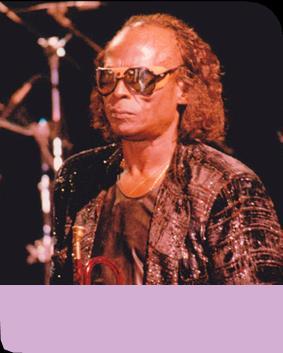
He collaborated with famous jazz players such as: Bill Evans, John Coltrane, Chick Corea, Philly Joe Jones, Joseph Zawinul, Paul Chambers, Herbie Hancock, Wayne Shorter, John McLaughlin, Keith Jarrett, and others. He retired from music in 1975 due to hip problems as well as his problems with drug addiction. He recovered and returned to music in 1980, collaborating with producer Marcus Miller and recording new, intriguing albums such as electronic-driven Tutu or Amandla, as well as Spanish-flavored mu-sic for Siesta (1987). Miles Davis is now arguably one of the greatest and most important jazz musicians of all time.
Miles Davis died of pneumonia, respiratory failure, and a stroke, on September 28, 1991, at St. John's Hospital and Health Center in Santa Monica, Calif. He was 65 years old.

Dancer,
Michael Joseph Jackson was born on August 29, 1958, in Gary, Indiana. Michael Jackson was one of nine children. His father, Joseph Jackson, believed his sons had talent and molded them into a musical group in the early 1960s that would later become known as the Jackson 5. As a child, Michael Jack- son became the lead singer of his family’s popular Motown group. Michael and his brothers spent endless hours rehearsing and polishing up their act. For several years, Michael Jackson and the Jackson 5 maintained a busy tour and recording schedule, under the supervision of Berry Gordy and his Motown staff. They became so popular that they even had their own self-titled cartoon show, which ran from 1971 to 1972.
Music Producer (1958 - 2009)
At the age of thirteen, Jackson launched a solo career in addition to his work with the Jackson 5, making the charts in 1971 with “Got to Be There,” from the album of the same name. Jackson’s 1972 album, Ben, featured the eponymous ballad about a rat. The song became Jackson’s first solo No. 1 single.
Released in 1982, Michael Jackson’s sixth solo album, Thriller, is the best-selling album in history, generating seven Top 10 hits. Thriller garnered 12 Grammy Award nominations, with eight wins. For his songwriting talents, he earned a Grammy (Best Rhythm and Blues Song) for “Billie Jean.” He was also honored for the singles “Thriller” (Best Pop Vocal Performance, Male) and “Beat It” (Best Rock Vocal Performance, Male). Jackson shared the award for Album of the Year with co-producer, Quincy Jones.
On a 1983 television special, Jackson performed his No. 1 hit “Billie Jean” and debuted his soon-to-be-famous dance move, the Moonwalk. Jackson created this step himself and choreographed the dance sequences for the video of the album’s other No. 1 hit, “Beat It. Known as the “King of Pop,” Michael Jackson became a best-selling American singer, songwriter, and dancer.
Michael Jackson died on June 25, 2009, at the age of fifty. He suffered cardiac arrest in his Los Angeles home. On July 7, 2009, a televised memorial was held for fans of the “King of Pop” at the Staples Center in downtown Los Angeles. While 17,500 free tickets were issued to fans via lottery, an estimated one billion viewers watched the memorial on TV or online.
Additionally, the King of Pop proved to have earning power that lasted well past his final days. In October 2017, Forbes announced that Jackson had topped the publication’s list of top-earning dead celebrities for the fifth straight year, racking in a whopping $75 million.
Born in 1942, in Seattle, Washington, Jimi Hendrix, Guitarist, singer, and songwriter, learned to play guitar as a teenager and grew up to become a rock legend who delighted audiences in the 1960s with his outrageous electric guitar playing skills and his experimental sound. One of his most memorable performances was at Woodstock in 1969, where he performed “The StarSpangled Banner.”
Jimi Hendrix was born Johnny Allen Hendrix (later changed by his father to James Marshall) on November 27, 1942, in Seattle, Washington. He had a difficult childhood, sometimes living in the care of relatives or acquaintances.

Darryl “DMC” McDaniels grew up in the same neighborhood, in Queens, New York, as his future RUN DMC mates, Joseph “Run” Simmons and Jason “Jam Master Jay” Mizell. The trio revolutionized rap and propelled it into mainstream culture.
In 1983, RUN DMC signed with Profile Records and collected a $2,500 advance. The group hit modest pay dirt with its first single, “It’s Like That/ Sucker MCs.” The song peaked at No. 15 on the R&B charts and helped pave the way for the band’s self-titled debut album in 1984.
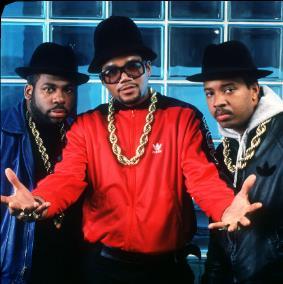
Musicians, Rappers (1983)
In many ways, music became a sanctuary for Hendrix. He was a fan of blues and rock and roll, and with his father’s encouragement he taught himself to play guitar. When Hendrix was sixteen, his father bought him his first acoustic guitar, and the next year his first electric guitar a right-handed Supro Ozark that the natural lefty had to flip upside down to play.
In 1959, he dropped out of high school to follow his musical aspirations. In 1961, Hendrix followed in his father’s footsteps by enlisting in the United States Army where he served in the army until 1962.
After an honorable discharge, Hendrix began working under the name Jimmy James as a session musician, playing backup for such performers as Little Richard, B.B. King, Sam Cooke, and the Isley Brothers.
In 1967, he released his first album, Are You Experienced? (1967), and the Jimi Hendrix Experience’s first single, “Hey Joe,” was an instant smash in Britain and was soon followed by hits such as “Purple Haze” and “The Wind Cries Mary.” Hendrix scored again with his second album, Axis: Bold as Love (1967). His final album, as part of the Jimi Hendrix Experience, Electric Ladyland (1968), featured the hit “All Along the Watchtower,” which was written by Bob Dylan. The band continued to tour until it split up in 1969. Hendrix died in 1970 from drug related complications, leaving his mark on the world of rock music and remaining popular to this day.
Branded by the group’s sportswear attire and hard-nosed street language, the record solidified RUN DMC’s reputation as the leaders of the new generation of hip -hop music.
The group’s 1985 album, King of Rock, continued RUN DMC’s momentum. But it was 1986’s platinum-selling Raising Hell, produced by Rick Rubin, that proved to be a signature record both for the band and hip-hop in general. It featured the highly touted single, “Walk This Way,” a rap version of Aerosmith’s 1975 smash hit of the same name. The song soared up the charts, pushing hip-hop into the mainstream and making RUN DMC music superstars.
The group racked up many firsts for a rap group: The first to have its music video played on MTV; the first to appear on the cover of Rolling Stone; and the first to perform on Saturday Night Live.
In 2009, the group was inducted into the Rock and Roll Hall of Fame, only the second rap group to earn the honor. In 2016, RUN DMC received rap’s first Grammy Lifetime Achievement Award.
Musician George Clinton was born in Kannapolis, North Carolina, July 22, 1941. His music career began in a barbershop where he created a doowop group called, The Parliaments. Clinton eventually reorganized the musicians who would become known as Funkadelic and Parliament to create new sounds and dazzling, out-of-this-world live shows with R&B chart toppers like "Flashlight", "Aqua Boogie" and "One Nation Under a Groove." He later embarked on a solo career, releasing the album Computer Games in 1982 as well as additional studio projects.
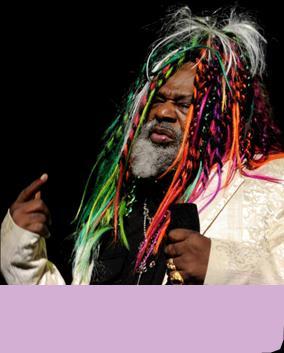
Clinton and Parliament-Funkadelic released more than 40 R&B hit singles and several gold and platinum albums during the '70s, all while cultivating another worldly, edgy aesthetic, partially inspired by sci-fi. By the time the musical powerhouse reached the '80s, Clinton became weighed down by legal difficulties arising from Polygram's acquisition of Parliament's label, Casablanca. Once again, Clinton was forced to rename the groups, in 1982, this time signing to Capitol as a solo act and as the P. Funk All-Stars.
In the 1990s, Clinton's music experienced a resurgence as rappers such as Snoop Dogg and Tupac Shakur began sampling his work. In 1997, he received an induction into the Rock and Roll Hall of Fame along with 15 other members of Parliament-Funkadelic.
Luther Vandross, born April 20, 1951, in New York City, was the youngest of four children. Vandross was raised by his mother after his father died. He became interested in R&B music during high school, and in 1972, his song “Everybody Rejoice” was picked up for the Broadway musical The Wiz. Soon after, he started recording commercial jingles and worked as a backup singer and arranger for such popular artists as David Bowie, Bette Midler, and Barbara Streisand.
In 1981, Vandross signed with Epic and released his debut album, Never Too Much, which sold more than a million copies. He released several subsequent albums throughout the 1980s, often partnering with such luminary female artists as Aretha Franklin. Though Vandross was a major R&B phenomenon, it was not until the early 1990s that he became a pop success. He won his first Grammy in 1991 for “Here and Now,” two in 1992 for co-writing and performing “Power of Love,” and a fourth in 1997 for “Your Secret Love.”
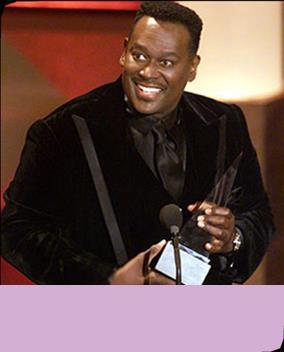
Vandross continued to produce recordings throughout the 1990s with immense success. These included a Top Ten remake of “Endless Love” with Mariah Carey, “This is Christmas” in 1996 and “I Know” in 1998. The singer suffered a debilitating stroke in 2003, from which he never fully recovered. He appeared via video at the 2004 Grammys, where he won four awards for his last album “Dance with My Father,” including Song of the Year. Vandross died on July 1, 2005.
Spike Lee was born Shelton Jackson Lee on March 20, 1957, in Atlanta, Georgia. The nowfamed actor, director, producer, and writer soon moved to Brooklyn, New York.
Growing up in a well-off African American family, Lee was making amateur films by age 20. His first student film, Last Hustle in Brooklyn, was completed when he was an undergraduate at More- house College. Lee went on to graduate from the New York University Film School in 1982. His thesis film, Joe’s Bed-Stuy Barbershop: We Cut Heads, won a Student Academy Award.
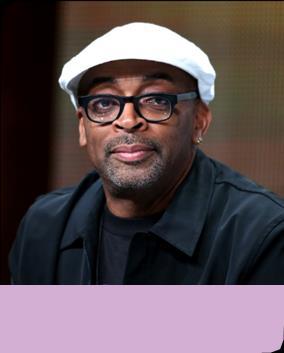
Lee drew attention with his first feature, She’s Gotta Have It The film was shot in two weeks and cost $175,000 to make, but grossed more than $7 million at the box office, making it one of the most profitable films created in 1986.
Lee often takes a critical look at and creates films that explore provocative topics such as: race relations, political issues and urban crime and violence. His 1989 film, Do the Right Thing, examined all the above and was nominated for an Academy Award for Best Original Screenplay.
Lee has also had success in directing television commercials, most famously opposite Michael Jordan in Nike’s Air Jordan campaign. In 2015, the acclaimed filmmaker received an honorary Oscar at the Academy of Motion Picture Arts and Sciences’ annual Governors Awards.
MICHAEL JORDAN
Jordan enrolled at the University of North Carolina at Chapel Hill. UNC won the NCAA Division I championships in1982, with Jordan scoring the final basket needed to defeat Georgetown University. For the next two years, he was singled out as the NCAA College Player of the Year in 1983 and in 1984.

During the summer of 1984, Jordan made his first appearance at the Olympic Games as a member of the U.S. Olympic basketball team; winning the gold medal; and, again, in 1992.
In 1985, Jordan finished his bachelor’s degree and continued to play in the NBA. He became the first player since Wilt Chamberlin to score more than 3,000 points in a single season. After the end of the 1992-93 basketball season, Michael Jordan announced his retirement from basketball to pursue baseball. For one year, he played in the minor leagues, as an outfielder. Jordan returned to the basketball court, in 1995, rejoining the Chicago Bulls, winning the champion- ship against the Seattle Sonics in the 1995-96 season. He led the Chicago Bulls to six NBA championships.
Retiring after the 1997-98 season, Jordan joined the Washington Wizards as a part owner and as president of basketball operations. In the fall of 2001, Jordan relinquished these roles to return to the court once more. He played for the Wizards for two seasons before hanging up his jersey for good in 2003.
Jordan received five regular-season MVPs and three All-Star MVPs. He received his first Most Valuable Player Award from the NBA in 1988—an honor he would earn four more times in 1991, 1992, 1996 and 1998. In April 2009, Jordan received one of basketball’s greatest honors: an induction into the Naismith Memorial Basketball Hall of Fame. In 2016, Jordan was presented with a Presidential Medal of Freedom honor by Barack Obama.
Singer and actress, Aaliyah Dana Haughton was born on January 16, 1979, in Brooklyn, New York. Raised in Detroit, Michigan, the young singer competed unsuccessfully on the television program Star Search at age 11. Later that same year, she performed with R&B legend Gladys Knight, the former wife of her uncle and manager, Barry Hankerson, at a five-night stand in Las Vegas.
In 1994, at the age of 15, Aaliyah catapulted onto the R&B charts herself with her debut album, Age Ain’t Nothing But a Number. Produced by the successful singer R. Kelly, the album quickly sold a million copies and eventually earned platinum status based on the success of two hit singles, “Back and Forth” and “At Your Best (You Are Love).”

Born into a musical family on 9 August 1963, in Newark, New Jersey, the daughter of gospel star Cissy Houston, cousin of singing star Dionne Warwick and goddaughter of soul legend Aretha Franklin.
She began singing in the choir as a young child and by the age of fifteen was singing background vocals professionally with her mother on Chaka Khan’s 1978 hit, ‘I’m Every Woman’. She went on to provide background vocals for Lou Rawls, Jermaine Jackson and her own mother and worked briefly as a model, appearing on the cover of ‘Seventeen’ magazine in 1981.

While a student in the dance program at Detroit High School for the Fine and Performing Arts, Aaliyah released her sophomore album, One in a Million (1996). The album sold two million copies.
Aaliyah gained even more recognition in 1997 when she recorded “Journey to the Past,” the Academy Award-nominated theme song to the animated feature Anastasia. She also performed the song for the Oscar telecast in 1998. Her next soundtrack effort, “Are You That Somebody?” for 1998’s Dr. Dolittle, starring Eddie Murphy, went to No. 1 on the R&B charts, was a pop crossover hit, and earned Aaliyah her first Grammy Award nomination.
In 2000, Aaliyah made her acting debut in the surprise action hit, Romeo Must Die. She was also an executive producer of the movie’s soundtrack and performed the hit single “Try Again,” which netted her a second Grammy nomination as well as two MTV Music Video Awards for Best Female Video and Best Video From a Film.
Her third album, Aaliyah, released in July 2001, reached No. 2 on the Billboard album chart. Also in 2001, she played the title role in Queen of the Damned, released in theaters in 2002. She signed to appear in two upcoming sequels to the blockbuster sci-fi thriller The Matrix, starring Keanu Reeves and Laurence Fishburne.
Aaliyah’s aspiring career came to an abrupt stop due to a crash resulting in her death. On her way home from a music video shoot in 2001, a plane crash killed Aaliyah and eight members of her film crew. She was 22 years old at the time of her death.
Whitney Houston began working as a featured vocalist for the New York based funk band, Material, and it was the quality of her vocal work with them that attracted the attention of the major record labels, including Arista with whom she signed in 1983 and where she stayed for the rest of her career. Her debut album, Whitney Houston, was released in 1985 and became the biggest-selling album by a debut artist. Several hit singles, including ‘Saving All My Love for You,’ ‘How Will I Know,’ ‘You Give Good Love,’ and ‘The Greatest Love of All,’ were released from the album, setting her up for a Beatles-beating seven consecutive US number ones. The album itself sold three million copies in its first year in the US and went on to sell twentyfive million worldwide, winning her the first of her six Grammys.
The 1987 follow-up album, Whitney, which included the hits “Where Do Broken Hearts Go,” and “I Wanna Dance with Somebody,” built on her success but it was the film The Bodyguard (1992) that sealed her place as one of the best-selling artists of all time. The soundtrack album and her cover of the Dolly Parton song, I Will Always Love You: The Best of Whitney Houston, topped the singles and albums charts for months and sold forty-four million copies around the world.
That same year she married ex-New Edition singer Bobby Brown with whom she had her only child, their daughter Bobbi Kristina Brown in March 1993. It was about this time that her much documented drug use began and by 1996 she was a daily user. Her 1998 album, My Love Is Your Love was well reviewed; but the drug abuse began to affect her reputation. She was dropped from a performance at the 72nd Annual Academy Awards (2000). She was admitted into rehab, twice; her weight fluctuating wildly, creating speculation after an appearance, in 2001, that she had died.
Her 2009 comeback album I Look to You was positively received and sold well, but promotional performances were still marred by her weakened voice. Her final acting performance was in Sparkle (2012), released after her death. She was found dead in a Beverly Hills hotel room on February 11, 2012.
Prince was born in Minneapolis, Minnesota, to Mattie Shaw, a jazz singer and social worker, and John L. Nelson, a lyricist and pianist. Prince had a troubled childhood. After separating from his mother and stepfather, Prince was adopted by the Andersons. Soon after, Prince, and two friends joined a band called Grand Central. The band later renamed themselves Champagne; before diminishing, soon after.

After age 18, Prince’s early demo tracks led him to signing a recording contract with Warner Brothers Records becoming the youngest producer associated with the label. Prince made his debut on the record label with his 1978 album, For You.
In 1984, Prince released what would be an admired and profound masterpiece, the feature film/soundtrack album, Purple Rain, with contributions from Prince’s father. In 1991, Prince assembled a new band called, The New Power Generation. Prince eventually changed his stage name from Prince to a symbol, which lead people to call him, “The Artist Formerly Known as Prince;” but, later took back his old stage name. In 2004, Prince performed at the Grammy Awards with Beyoncé Knowles. That same year he was inducted into the Rock and Roll Hall of Fame.
That spring, he released Musicology. The album won two Grammys and added another dreamy ballad, “Call My Name.” He wrote and performed “Song of the Heart” for the animated film Happy Feet, and won a Golden Globe (Best Origi- nal Song) for the composition. In 2010 he earned a Lifetime Achievement Award from the BET Awards. He ended the year with an induction into the Grammy Hall of Fame.
Although Prince married twice, he was extremely private about his personal life.
Prince was against the trend of the Internet as the primary force for distributng music, having songs shared at will on the web; and, refused to provide his songs to online music platforms without proper upfront compensation and profit sharing.
Prince took a political stand with his performance on May 2, 2015. Prince staged a Dance Rally 4 Peace at Paisley Park to pay tribute and to show support for the activists protesting the death of Freddie Gray, a 25-year-old African-American who died in police custody after his arrest in Baltimore.
Prince died on April 21, 2016 in Chanhassen, Minnesota, at his Paisley Park recording studio complex. He was 57.
Beyoncé was born on September 4, 1981, in Houston, Texas. She started singing at an early age, competing in local talent shows and winning many of these events. Teaming up with her cousin, Kelly Rowland, and two classmates, Beyoncé formed an all-female singing group. She first captured the public’s eye as lead vocalist of the R&B group Destiny’s Child, and later established a solo career with her debut album Dangerously in Love, becoming one of music’s top-selling artists with sold-out tours and a slew of awards. She also starred in several films, including Dream Girls

At the 2010 Grammy Awards, Beyoncé walked away with six honors the most wins in a single night by a female artist. In 2010, she also tied the record for most No. 1 hits on Billboard’s Pop Songs chart, which is based on radio airplay. In 2011, she made the Forbes Top 10 list of entertainment’s highest-earning women. By 2013, Beyoncé had won 16 Grammys.
The famed singer, known as, “Queen Bey,” broke records once again on December 13, 2013, with her fifth studio album, self-titled Beyoncé. The album surprised fans and critics alike, as no promotion for the album had been announced prior to its release. The record, which Beyoncé called a “visual album,” was released exclusively on iTunes, with physical discs available for purchase after December 18. The record-breaking album sold more than 800,000 copies throughout the weekend.
The Collection which was the fastest-selling album ever distributed by iTunes also marked Beyoncé’s fifth studio album to debut at No. 1, making her the first woman to reach No. 1 on the Billboard 200 with her first five albums. She released the Platinum Edition of the album in 2014, and the following year won three additional Grammys, including a Best R&B Performance award for “Drunk in Love.” In 2017, Queen Bey also reigned as the highest-earning female musician of the year. According to Forbes, Beyoncé snagged $105 million in pretax income June 2016 through June 2017.
Married to Jay-Z since 2008, the couple welcomed a baby daughter, Blue Ivy, on January 7, 2012. In February 2017, Beyoncé announced that she and Jay-Z were expecting twins. The iconic shot was the year’s most-liked Instagram post, with 11.1 million fans. In June 2017, they welcomed twins, a boy, Sir Carter, and a girl, Rumi.
Lesane Parish Crooks, artistically named “2Pac” and “Makaveli” was born June 16, 1971, Brooklyn, New York, Crooks was born to Alice Faye Williams, a member of the Black Panther Party, and she renamed him Tupac Amaru Shakur after Peruvian revolutionary Tupac Amaru II when he was a year old. Shakur attended the elite Baltimore School of the Arts where he distinguished himself as a student, both creatively and academically.

Shortly after the family relocated to Marin City, California, Shakur took to the streets, selling drugs and becoming involved in the gang culture that would one day provide material for his rap lyrics. In 1990 he joined Digital Underground, an Oakland-based rap group that had scored a Billboard Top 40 hit with the novelty single “The Humpty Dance.” Shakur performed on two Digital Underground albums in 1991, This Is an EP Release and Sons of the P, before his solo debut, 2Pacalypse Now, later that year.
That same year Shakur joined the ranks of other rappers-turned-actors, such as Ice Cube and Ice-T, when he was cast in the motion picture, Juice, an urban crime drama. The following year he appeared in Poetic Justice, opposite Janet Jackson, and he released his second album. The album did not stray far from the activist lyricism of his debut, but singles such as “Holler If Ya Hear Me” and “Keep Ya Head Up” made it much more radio-friendly.
With increased fame and success came greater scrutiny of Shakur’s gangsta’ life- style. A string of arrests culminated with a conviction for sexual assault in 1994. He was incarcerated when his third album, Me Against the World, was released in 1995. Shakur was paroled after serving eight months in prison, and he signed with Suge Knight’s Death Row Records for his next release. That album, All Eyez on Me (1996), was a two-disc paean to the “thug life” that Shakur embodied. It debuted at number one on the Billboard charts and sold more than five million copies within its first year of release. Shakur returned to Hollywood, where he starred in Bullet (1996) and Gridlock’d (1997).
On the evening of September 7, 1996, an unknown assailant shot Shakur. Shakur died six days later. Shakur left an enduring legacy within the hip-hop community. His popularity was undiminished after his death, which was followed by a long succession of posthumous releases.
Colin Rand Kaepernick was born on November 3, 1987, in Milwaukee, Wisconsin. He was just a few weeks old when he was adopted by Rick and Teresa Kaepernick, who already had two children of their own.
Colin Kaepernick showed athletic promise at an early age. He began playing youth football at age 8. His strong arm quickly elevated him to the quarterback position. That same arm also made him an elite high school pitcher, throwing a fastball at 94 miles per hour.
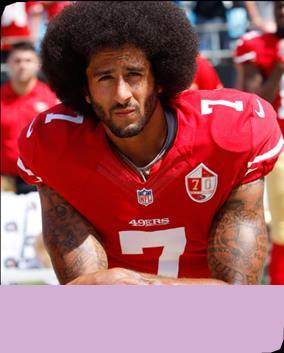
But football was Kaepernick’s first love. In the fourth grade, he even penned a letter predicting that he would be the starting quarterback for the San Francisco 49ers.
At John H. Pitman High School in Turlock, California, Kaepernick was a first-team All-District, All-Conference and All-Academic selection; but was passed over by the major college football programs because of concerns about his arm and his razor thin frame.
Kaepernick attended the University of Nevada. He set several school records and became the first quarterback in the history of Division I FBS to pass for more than 10,000 yards and rush for more than 4,000 yards.
The San Francisco 49ers drafted Kaepernick in 2011, and less than two years later, he led the club to Super Bowl XLVII.
In 2016, Kaepernick drew attention for refusing to stand for the national anthem. This pre-game protest was adopted by other players and became a hot-button political topic. His refusal to stand for the anthem drew both support and condemnation from fellow NFL players, politicians and celebrities.
Gaining national attention, in 2017, Kaepernick appeared on the cover of GQ as its “Citizen of the Year.” He was honored with the Eason Monroe Courageous Advocate Award at the ACLU of Southern California’s annual Bill of Rights dinner. He was a finalist for TIME’s Person of the Year designation. Kaepernick soon earned more recognition as the recipient of Sports Illustrated’s Muhammad Ali Legacy Award, given to former athletes and sports figures who embody the ideals of sportsmanship, leadership, and philanthropy as vehicles for changing the world.
Despite his many successes on the field, Colin Kaepernick was purportedly unsigned in the 2018 NFL season because he took a stance against inequality in the United States.
Brian D. Waters was born February 18, 1977, in Waxahachie, Texas, and attended Waxahachie High School. Waters attended the University of North Texas where he played for the North Texas Mean Green football team.
Although, the Dallas Cowboys signed Waters as an undrafted free agent after the 1999 NFL draft to play tight end and fullback; he was released during training camp.
The Kansas City Chiefs signed him as a free agent during the 2000 offseason.

Waters was named an All-Pro twice and was selected to the Pro Bowl five times in his eleven-year career with the Kansas City Chiefs. He would earn six Pro Bowl selections during his career. In 2003, he was a part of a 13-3 Chiefs team.
During the 2004 season, Waters was selected as the AFC Offensive Player of the Week for his play during a game against the Atlanta Falcons on October 24, 2004. Waters is the only offensive lineman in the AFC to have received the award, and the only lineman in the NFL to win since 1992. Waters was recognized as the recipient of the 2009 Walter Payton Man of the Year Award which honors a player’s contribution on the field as well as off.
On September 4, 2011, Waters signed with the New England Patriots. Waters, who started every game at right guard for the Patriots, was voted a starter for the Pro Bowl. Waters played for the Patriots in Super Bowl XLVI.
On September 3, 2013, the Dallas Cowboys signed Waters to a one-year contract worth $3 million. On September 2, 2014, Waters announced his retirement from professional football.
Our Senior Pastor, Dr. Dante D. Wright I, and Brian D. Waters, once shared the same football field: our Pastor, a University of North Texas Positions Coach, and Brian D. Waters, a University of North Texas, football player. What started by chance has been the foundation of long-term friendship. Identifying, our Pastor, Dr. Dante D. Wright, in an interview with ESPN, Waters identified our Pastor Wright, as a great friend and mentor.
Brian Waters is a benefactor and remains a friend to Sweet Home Baptist Church (affectionately known as The Pinnacle of Praise). The current worship facility is named after and hosts a plaque in honor of Brian D. Waters.
Barack Hussein Obama II was born on August 4, 1961, in Honolulu, Hawaii. At an early age, Obama’s mother married and moved the family to Indonesia.
At the age of ten, Obama was sent back to Hawaii to live with his maternal grandparents.
He was enrolled in the esteemed Punahou Academy. He excelled in basketball and graduated with academic honors in 1979. As one of only three Black students at the school, Obama became conscious of racism and what it meant to be African American.
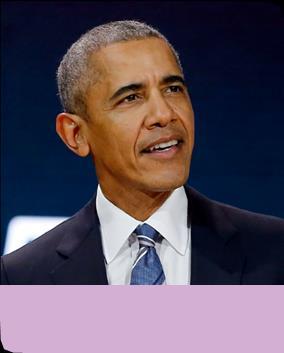
He later described how he struggled to reconcile social perceptions of his multiracial heritage with his own sense of self.
In 1985, he moved to Chicago and worked as a community organizer for low income residents; and although “not raised in a religious household,” Obama joined the Trinity United Church of Christ.
After a visit to Kenya, his father’s homeland, Obama enrolled in Harvard Law School, in 1988. That same year Obama worked as a summer associate at a law firm where he met, Michelle Robinson. They later married in 1992 and had two children. In February 1990, Obama was elected the first African American editor of the Harvard Law Review, later graduating magna cum laude from Harvard Law, in 1991. He returned to Chicago to practice as a civil rights lawyer, where he also taught constitutional law part-time at the University of Chicago Law School between 1992 and 2004.
Obama published an autobiography, Dreams from My Father: A Story of Race and Inheritance, in 1995. The work received high praise and has since been printed in more than 25 languages. The audiobook version of Dreams, narrated by Obama, received a Grammy Award for best spoken word album, in 2006.
Obama’s advocacy work led him to run for a seat in the Illinois State Senate. He ran as a Democrat and won the election in 1996. Obama worked to draft legislation on ethics, as well as expand health care services and early childhood education programs for the poor. He created a state earned-income tax credit for the working poor; and he worked with law enforcement officials to require the videotaping of interrogations and confessions in all capital cases.
In 2004, Obama delivered the keynote speech at the Democratic National Convention and became only the third African American elected to the U.S. Senate since Reconstruction. On November 4, 2008, Barack Obama was elected as the 44th president of the United States the first African American to hold this office. He served two terms, from 2009 until 2017. In 2009, he was also awarded the Nobel Peace Prize. Today, his work and his achievements inspire others to work to accomplish their dreams.
Michelle Obama was born Michelle Lavaughn Robinson on January 17, 1964, in Chicago, Illinois. Michelle was raised in a small bungalow on Chicago’s South Side. Michelle and her brother were raised with an emphasis on education and learned to read at home by age four.
By the sixth grade, Michelle was taking classes in her school’s gifted program. She went on to attend Whitney M. Young Magnet High School, the city’s first magnet high school for gifted children. In 1981, Michelle graduated from the school as class salutatorian.

Michelle attended Princeton University, graduating cum laude in 1985 with a B.A. in Sociology; then, went on to study law at Harvard Law School. She was awarded her J.D., in 1988. After law school, Michelle worked as an associate in the Chicago branch of the firm Sidley Austin where she met Barack Obama, a summer intern, to whom she was assigned to be his adviser. They later married, in 1992, and had two children.
In 1991, Michelle left corporate law to pursue a career in public service. In 1993, she became Executive Director for the Chicago Office of Public Allies. In 1996, Michelle joined the University of Chicago as Associate Dean of Student Services, developing the school’s first community-service program. In 2002, she worked for the University of Chicago Hospitals, as Executive Director of Community Relations and External Affairs. In May 2005, Michelle was appointed Vice President for Community and External Affairs at the University of Chicago Medical Center, where she continued to work part-time until shortly before her husband’s inauguration as President of the United States. She also served as a board member for the prestigious Chicago Council on Global Affairs.
In 2007, Michelle scaled back her own professional work to fulfill family and campaign obligations during Barack’s run for the Democratic presidential nomination.
As First Lady of the United States, Michelle Obama focused on supporting military families, helping working women balance career and family and encouraging national service. She fought childhood obesity and supported the organic-food movement. In 2012, she announced a new fitness program for kids as part of her Let’s Move initiative.
On January 13, 2017, Obama made her final speech as First Lady at the White House, saying “being your First Lady has been the greatest honor of my life and I hope I’ve made you proud.”


Located